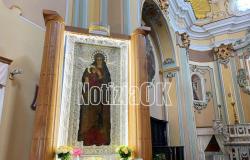Friday 26 April at 9.00 pm, after having received applause and appreciation in the theaters of Turin, Milan, Rome and other prestigious national stages, it debuts at the Teatro Biondo in Palermo The girl on the sofa (Jenta i sofanen2002) by Jon FosseNorwegian author awarded the Nobel Prize for Literature in 2023. The translation of the text is by Graziella Perin.
To direct the show, co-produced by Biondo Theater in Palermo and from Teatro Stabile di Torino – National TheatreAnd Valerio Binascowho he is also on stage with Pamela Villoresi, Michele Di Mauro, Giordana Faggiano, Fabrizio Contri, Giulia Chiaramonte and with Isabella Ferrari. The scenes and lights are by Nicolas Boveythe costumes of Alessio Rosatithe sound of Filippo Conti.
Repeats at the Biondo until 5 May and then at the Teatro Mercadante in Naples from 7 to 12 May.
Valerio Binasco is the main interpreter, in Italy, of Jon Fosse’s theatre, with productions that reveal the almost Proustian relationship that the Norwegian master’s works trace between past and present. In this new show, Pamela Villoresi plays a middle-aged woman coming to terms with her past, while she is busy painting a portrait of a girl crouched on a sofa. The painter faces the ghosts of her life, troubled by a thousand uncertainties, and fights against doubts about her artistic abilities. The image of her that haunts her, the girl crouched on a sofa, is that of herself as a young woman.
Little by little, like materializations of his own stream of consciousness, other family figures appear on the scene: his mother, with whom he has always had a bad relationship; her sexually uninhibited sister, whom she envied so much; his sailor father, whom he adored but who was little present in his life; the uncle who took his place in a Hamlet-like situation. The strength of this piece lies in the mixed times: everything on the stage happens simultaneously, creating a series of unsettling short circuits. The director resolves this overlap of times and places with an ingenious mechanism that could be defined as cinematic, masterfully exploring the way in which the psychic wounds inflicted in childhood never completely heal.
The girl on the sofa it develops in an inexorable and cruel way, it saves no one, it unmasks hypocrisies and reveals an impressive theory of betrayals, cowardice, perversions of the flesh and the soul.
«The main theme of this piece – explains Valerio Binasco – is abandonment. In many of Fosse’s works, a woman returns, like a recurring dream, waiting for the return of a man who is
He left for sea and never returned. Neither The girl on the sofa the paintings that the Woman paints are the point of view of those who watch a ship leave and vanish towards a hostile horizon, a symbol of a threat that obviously does not only concern the sea. But we can also look for in that painting the symbolism of a ship leaving the storm behind.
The reasons that push me to insist on an author like Fosse are mysterious even to me. His obsessive and minimal style seduces me, period. I think the main quality about him is his pace. This rhythm, despite appearing slow or even inert, is actually never “on the beat”, but on the contrary has an obsessively “upbeat” trend, even and above all when the action seems to proceed with exasperated slowness. It’s a poetic rhythm. There is always a deep sense of humor in proceeding “upbeat”. That is why, although his themes are mostly very sad, and often even tragic, tragedy and sadness are not in the foreground. In the foreground there is something else, and that is mainly the suspended atmospheres, and the serious, almost harsh, inexpressive humorous aplomb of the characters and performers.”
__________________________
director’s notes
The main theme of this play is abandonment. In many of Fosse’s works, a woman returns, like a recurring dream, waiting for the return of a man who left for sea and never returned. Neither The girl on the sofa the paintings that the Woman paints are the point of view of those who watch a ship leave and vanish towards a hostile horizon, a symbol of a threat that obviously does not only concern the sea. But we can also look for in that painting the symbolism of a ship leaving the storm behind.
The wound of this family is that of abandonment. The Father is a fugitive soul who can’t stand his wife and daughters and any form of marital normality. He is married to the sea, as an actor is to the theatre. The three women faced the disease of abandonment in three different ways: the mother is full of hatred for the father, and rightly so. For this reason, for the Mother and for the Sister, who is a young alter ego of the mother, the father’s escape is an unbearable humiliation. The Sister is fundamental in this story. Her rebellion is very fascinating: she becomes a ‘whore’, and simply repeats to the Girl that the Father certainly frequents whores around the world. The Sister seems to have saved herself from the abandonment complex by adopting behaviors that seem specifically designed to hit her obsessive internal target: her father. She too throws herself into the world, like her father, she leaves home, goes through the storm of femininity, rides it, tames it, becomes queen of the night and satisfies the desires of men. She inflicts sentimental humiliation on herself in order not to let herself be submerged by the storm. She rebels against the romantic-sentimental idea of love and the family founded on love, she rebels to get rid of it. Thanks to this revolt, she deeply understands her mother, and loves her. In the war against her father, she took sides, while the Girl took the opposite side. The Mother senses this, and she lets the hatred she feels for the Father reflect on the Girl as well. They will never forgive themselves.
I think the heart of the play is the disease of incompleteness in life and art. The painting of the ship is unfinished, but incompleteness is probably not part of the purpose
expressive expressions of the painter (the Woman). The protagonist feels chronic frustration, she hates her art with which she has a relationship of serious ambivalence. Her creativity has never evolved to a stage of pleasure, but she has remained at a stage of art that arises from emotional wounds.
This drama is (also) a story of brothers and sisters: two adult brothers and two very young sisters. Then the same sisters, as elders. A wife (the Mother) was abandoned; the other wife (the Woman) has abandoned her husband. The Woman is incapable of loving him, and of feeling loved. Being a gentle man, the husband will give in to this abandonment. There is a weakness of soul in him that can only be sensed: he is a disoriented, succumbing character. It is part of a psychological story (that of the Woman and the pain of her abandonment) bigger than him. His meekness and caring behavior were not enough for the Woman. That she’s looking for a very different kind of man. Or perhaps she is not looking for anything or anyone, lost as she is in the contemplation of the void left by her Father, a void that has become populated in her with painted figures.
The reasons that push me to insist on an author like Jon Fosse are mysterious even to me. His obsessive and minimal style seduces me, period. I think the main quality about him is his pace. This rhythm, despite appearing slow or even inert, is actually never “on the beat”, but on the contrary has an obsessively “upbeat” trend, even and above all when the action seems to proceed with exasperated slowness. It’s a poetic rhythm. There is always a deep sense of humor in proceeding “upbeat”. That is why, although his themes are mostly very sad, and often even tragic, tragedy and sadness are not in the foreground. In the foreground there is something else, namely mainly the suspended atmospheres, and the serious, almost harsh, inexpressive humorous aplomb of the characters and performers.
______________________
Jon Fosse, Nobel Prize winner for literature 2023, was born in 1959 in Haugesund, Norway. A serious accident at the age of seven brought him close to death; the experience significantly influenced his writing in adulthood. He graduated from the University of Bergen in comparative literature. Fosse wrote novels, short stories, poems, children’s books, essays and plays; his works are translated into more than forty languages. Knighted ofOrdre national du Merite of France in 2003, he was included in the list of the 100 best living geniuses by the “Daily Telegraph”. Since 2011, Fosse has been granted the Grotten, an honorary residence owned by the Norwegian state and located on the premises of the Royal Palace in the city center of Oslo. The use of the Grotten as a permanent residence is an honor specially bestowed by the King of Norway for contributions to Norwegian arts and culture.
Fosse is the most emblematic writer of the contemporary theater scene, author of works with a spare, minimal, no-frills writing, which give voice, with lucid analysis, to the discomfort that arises from the communication barriers placed between the men and women of our era, between figures of different ages, between people separated by family ties, between living subjects and shadows. In his lyrics created for the stage, from 1994 onwards, ruthless stories and little relationships are told
flattering and inscrutable tragedies that restore the barely spoken silence and the always laconic dialogues of individuals who, by reducing social, domestic and affectionate language to a minimum, end up touching the most exposed nerve, the most widespread plague of our days: indifference. The shipwreck of the family and the couple, the moral drift of the male and the protective and cannibalistic solitude of the female are the themes of his repertoire. Her language is deliberately anemic, aphasic, parsimonious. His punctuation is nil.
Due to the atmospheres of his texts, the themes and the sources of inspiration he is considered the greatest heir of the Scandinavian literary and theatrical tradition (Strindberg, Ibsen, but also Bergman).
______________________
The girl on the sofa
by Jon Fosse
translation Graziella Perin
with (performers and characters)
Pamela Villoresi Woman
Isabella Ferrari Mother
Giordana Faggiano Lass
Giulia Chiaramonte Sister
Valerio Binasco Man
Michele Di Mauro Uncle
Fabrizio Contri Father
directed by Valerio Binasco
sets and lights Nicolas Bovey
costumes Alessio Rosati
sound Filippo Conti
video and painting Simone Rosset
assistant director Eleonora Bentivoglio
stage assistant Eleonora De Leo
costume assistant Rosa Mariotti
IAD trainee (Belgium) Sarah Galateri from Genola
responsible for the artistic, programming and training area Barbara Ferrato
production area manager Salvo Caldarella
stage manager Marco Albertano
stage director Marco Anedda, chief stagehand Kreshnik Sukni, stagehand Giovanni Iaria
chief electrician Dario Gargiulo, electrician Massimo Quarta, sound engineer Simone Torchio
head dressmaker Michela Pagano, make-up and hairstylist Serena Gioia, company secretary Eleonora Bentivoglio
set designer Ermes Pancaldi, prop designers Claudia Trapanà, Greta Maggialetti
scene construction Laboratory of the Teatro Stabile of Turin – National Theatre
stage technician laboratory coordinator Antioco Lusci, stagehands Lorenzo Passarella, Luca Degiuli,
Giacomo Gheller Cavallera, still photo Virginia Mingolla
production Teatro Biondo Palermo / Teatro Stabile di Torino – Teatro Nazionale
in agreement with Arcadia & Ricono Ltd courtesy of Colombine Teaterförlag
duration: 1 hour and 10 minutes
Teatro Biondo Palermo, Sala Grande – from 26 April to 5 May 2024
performance calendar:
Friday 26 April, 9.00 pm
Saturday 27 April, 7.00 pm
Sunday 28 April, 5pm
Monday 29 April, 5pm
Tuesday 30 April, 9.00 pm
Thursday 2 May, 5.00 pm
Friday 3 May, 9.00 pm
Saturday 4 May, 7.00 pm
Sunday 5 May, 5.00 pm
Tags: girl sofa Municipality Palermo




